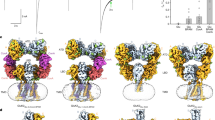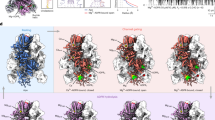Abstract
The cell-to-cell permeability of the junctions of various cultured mammalian cell types depends on the concentration of intracellular cyclic AMP ([cAMP]i). The permeability rises when the cells are supplied with exogenous cyclic AMP or when their cyclic AMP synthesis is stimulated with choleragen or hormones; it falls when [cAMP]i is lowered by application of serum or due to increase in cell density1–5. The rise and fall in permeability take several hours to develop (the rise is protein synthesis-dependent) and they occur concurrently with the rise and fall in the number of intramembrane particles of the gap junctions2–4, which probably embody the cell-to-cell channels. Is this permeability regulation mediated by phosphorylating protein kinase? In many eukaryotes, the cyclic AMP receptor is a protein kinase6–8 consisting of a pair of regulatory subunits and a pair of catalytic subunits. The latter dissociate from the holoenzyme as the cyclic AMP binds to the regulatory subunits and, in this dissociated form, catalyse the phosphorylation of the target9. The regulatory subunit occurs in two isoenzyme forms, I and II. The catalytic subunit seems invariant9; subunits from different isoenzymes can substitute for each other10,11. We show here that a mutant cell lacking the isoenzyme I is deficient in permeable junctions, and that this junctional defect is corrected when the mutant is supplied with exogenous catalytic subunit.
This is a preview of subscription content, access via your institution
Access options
Subscribe to this journal
Receive 51 print issues and online access
$199.00 per year
only $3.90 per issue
Buy this article
- Purchase on Springer Link
- Instant access to full article PDF
Prices may be subject to local taxes which are calculated during checkout
Similar content being viewed by others
References
Flagg-Newton, J. L. & Loewenstein, W. R. J. Membrane Biol. 63, 123–131 (1981).
Flagg-Newton, J. L., Dahl, G. & Loewenstein, W. R. J. Membrane Biol. 63, 105–121 (1981).
Azarnia, R., Dahl, G. & Loewenstein, W. R. J. Membrane Biol. 63, 133–146 (1981).
Radu, A., Dahl, G. & Loewenstein, W. R. J. Membrane Biol. 70, 239–251 (1982).
Loewenstein, W. R. Physiol. Rev. 61, 829–913 (1981).
Kuo, J. F. & Greengard, P. Proc. natn. Acad. Sci. U.S.A. 64, 1349–1355 (1969).
Krebs, E. G. Curr. Topics cell. Regulation 5, 99–133 (1972).
Nimmo, H. G. & Cohen, P. Adv. Cyclic Nucleotide Res. 8, 145–266 (1977).
Rosen, O. M. & Krebs, E. G. (eds) Cold Spring Harb. Conf. Cell Proliferation Vol. 8A,B (Cold Spring Harbor Laboratory, New York, 1981).
Yamamura, H., Kumon, A. & Nishizuka, Y. J. biol. Chem. 246, 1544–1547 (1971).
Miyamoto, E., Petzold, G. L., Kuo, J. F. & Greengard, P. J. biol. Chem. 248, 179–189 (1973).
Gottesman, M. M. et al. in Cold Spring Harb. Conf. Cell Proliferation Vol. 8A (eds Rosen, O. M. & Krebs, E. G.) 195–209 (Cold Spring Harbor Laboratory, New York, 1981).
Kerrick, W. G. L. & Krasner, B. J. appl. Physiol. 39, 1052–1055 (1975).
Beavo, J. A., Bechtel, P. J. & Krebs, E. G. Meth. Enzym. 38, 299 (1974).
Bourguignon, L. & Kerrick, W. G. L. J. Membrane Biol. (in the press).
Kerrick, W. G. L. & Hoar, P. Nature 292, 253–255 (1981).
Johnson, K. R., Johnson, R. Fedn Proc. 41, 755 (1982).
Evain, D., Gottesman, M. M., Pastan, I. & Anderson, W. B. J. biol. Chem. 254, 6931–6937 (1979).
Corbin, J. D. & Reimann, E. M. Meth. Enzy. 38, 287–290 (1974).
Simpson, I., Rose, B. & Loewenstein, W. R. Science 195, 294–296 (1977).
Schwarzmann, G. et al. Science 213, 551–553 (1981).
Author information
Authors and Affiliations
Rights and permissions
About this article
Cite this article
Wiener, E., Loewenstein, W. Correction of cell–cell communication defect by introduction of a protein kinase into mutant cells. Nature 305, 433–435 (1983). https://doi.org/10.1038/305433a0
Received:
Accepted:
Issue Date:
DOI: https://doi.org/10.1038/305433a0
This article is cited by
-
Magnitude and modulation of pancreatic β-cell gap junction electrical conductance in situ
The Journal of Membrane Biology (1995)
-
Dye and electric coupling between osteoblast-like cells in culture
Calcified Tissue International (1993)
-
Expression of the gap junction protein connexin43 in embryonic chick lens: Molecular cloning, ultrastructural localization, and post-translational phosphorylation
The Journal of Membrane Biology (1990)
-
Phosphorylation of MP26, a lens junction protein, is enhanced by activators of protein kinase C
The Journal of Membrane Biology (1989)
Comments
By submitting a comment you agree to abide by our Terms and Community Guidelines. If you find something abusive or that does not comply with our terms or guidelines please flag it as inappropriate.



